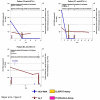Clearance of low levels of HCV viremia in the absence of a strong adaptive immune response
- PMID: 17562015
- PMCID: PMC1914341
- DOI: 10.1186/1743-422X-4-58
Clearance of low levels of HCV viremia in the absence of a strong adaptive immune response
Abstract
Spontaneous clearance of hepatitis C virus (HCV) has frequently been associated with the presence of HCV-specific cellular immunity. However, there had been also reports in chimpanzees demonstrating clearance of HCV-viremia in the absence of significant levels of detectable HCV-specific cellular immune responses. We here report seven asymptomatic acute hepatitis C cases with peak HCV-RNA levels between 300 and 100,000 copies/ml who all cleared HCV-RNA spontaneously. Patients were identified by a systematic screening of 1176 consecutive new incoming offenders in a German young offender institution. Four of the seven patients never developed anti-HCV antibodies and had normal ALT levels throughout follow-up. Transient weak HCV-specific CD4+ T cell responses were detectable in five individuals which did not differ in strength and breadth from age- and sex-matched patients with chronic hepatitis C and long-term recovered patients. In contrast, HCV-specific MHC-class-I-tetramer-positive cells were found in 3 of 4 HLA-A2-positive patients. Thus, these cases highlight that clearance of low levels of HCV viremia is possible in the absence of a strong adaptive immune response which might explain the low seroconversion rate after occupational exposure to HCV.
Figures



Similar articles
-
Clearance of hepatitis C viremia associated with cellular immunity in the absence of seroconversion in the hepatitis C incidence and transmission in prisons study cohort.J Infect Dis. 2004 May 15;189(10):1846-55. doi: 10.1086/383279. Epub 2004 Apr 26. J Infect Dis. 2004. PMID: 15122521
-
Kinetics of CD4+ and CD8+ memory T-cell responses during hepatitis C virus rechallenge of previously recovered chimpanzees.J Virol. 2003 Apr;77(8):4781-93. doi: 10.1128/jvi.77.8.4781-4793.2003. J Virol. 2003. PMID: 12663785 Free PMC article.
-
Exposure to low infective doses of HCV induces cellular immune responses without consistently detectable viremia or seroconversion in chimpanzees.Virology. 2003 Sep 30;314(2):601-16. doi: 10.1016/s0042-6822(03)00461-6. Virology. 2003. PMID: 14554088 Free PMC article.
-
Viral and host immune regulatory mechanisms in hepatitis C virus infection.Eur J Gastroenterol Hepatol. 2006 Apr;18(4):327-31. doi: 10.1097/00042737-200604000-00004. Eur J Gastroenterol Hepatol. 2006. PMID: 16538102 Review.
-
Immunological determinants of the outcomes from primary hepatitis C infection.Cell Mol Life Sci. 2009 Mar;66(5):733-56. doi: 10.1007/s00018-008-8270-4. Cell Mol Life Sci. 2009. PMID: 19011759 Free PMC article. Review.
Cited by
-
New tools in HCV diagnosis, in light of the enhanced awareness and the new drugs for treatment: SMARTube and stimmunology.ScientificWorldJournal. 2013;2013:389780. doi: 10.1155/2013/389780. Epub 2013 Feb 14. ScientificWorldJournal. 2013. PMID: 23476130 Free PMC article.
-
Type III Interferons in Hepatitis C Virus Infection.Front Immunol. 2016 Dec 23;7:628. doi: 10.3389/fimmu.2016.00628. eCollection 2016. Front Immunol. 2016. PMID: 28066437 Free PMC article. Review.
-
Frequent transient hepatitis C viremia without seroconversion among healthcare workers in Cairo, Egypt.PLoS One. 2013;8(2):e57835. doi: 10.1371/journal.pone.0057835. Epub 2013 Feb 28. PLoS One. 2013. PMID: 23469082 Free PMC article.
-
Hepatitis C virus-specific cellular immune responses in individuals with no evidence of infection.Virol J. 2012 Mar 28;9:76. doi: 10.1186/1743-422X-9-76. Virol J. 2012. PMID: 22455516 Free PMC article.
-
TH1 cytokine response to HCV peptides in Egyptian health care workers: a pilot study.Virol J. 2013 May 11;10:144. doi: 10.1186/1743-422X-10-144. Virol J. 2013. PMID: 23663415 Free PMC article.
References
-
- Erickson AL, Kimura Y, Igarashi S, Eichelberger J, Houghton M, Sidney J, McKinney D, Sette A, Hughes AL, Walker CM. The outcome of hepatitis C virus infection is predicted by escape mutations in epitopes targeted by cytotoxic T lymphocytes. Immunity. 2001;15:883–895. doi: 10.1016/S1074-7613(01)00245-X. - DOI - PubMed
-
- Thimme R, Bukh J, Spangenberg HC, Wieland S, Pemberton J, Steiger C, Govindarajan S, Purcell RH, Chisari FV. Viral and immunological determinants of hepatitis C virus clearance, persistence, and disease. Proc Natl Acad Sci U S A. 2002;99:15661–15668. doi: 10.1073/pnas.202608299. - DOI - PMC - PubMed
MeSH terms
Substances
LinkOut - more resources
Full Text Sources
Medical
Research Materials

